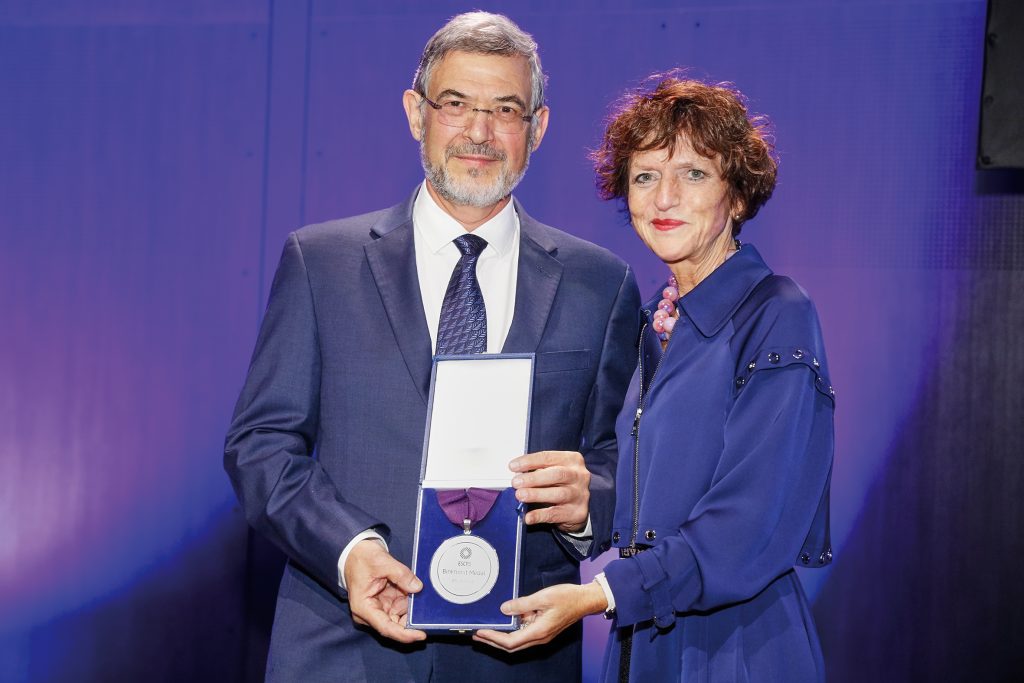Celebrating creative thinking
Binkhorst Medal Lecture covered the power that comes from challenging conventional thinking

Dermot McGrath
Published: Monday, September 16, 2019
 Ehud Assia, receiving the Binkhorst Medal from ESCRS President Béatrice Cochener-Lamard[/caption]
The capacity to “think outside the box” and not be afraid to challenge conventional thinking represents a powerful means to advance medical science and has been the creative starting point for many key innovations in cataract surgery, said Ehud Assia MD in his Binkhorst Medal Lecture during the Opening Ceremony of the 37th Congress of the ESCRS.
“In order to come up with new ideas and innovations we often need to think differently, to approach things from a different perspective or in an unconventional way so that we can see things that we have not imagined or thought of before,” he said.
In a wide-ranging lecture, Dr Assia spoke about the power that comes from challenging conventional thinking and how this approach directly led to his own various innovations in the field of cataract surgery.
Innovation is a continuous and ongoing process, said Dr Assia, citing the amusing quote of the Commissioner of the United States patent office Charles Holland Duell, who in 1889 stated that “everything that can be invented has been invented”.
“I think he got that one wrong,” said Dr Assia, noting that there are now over 10 million patents in the United States alone and the number continues to increase every year.
Dr Assia’s own research has sought to develop new surgical devices and technologies by considering issues from different angles and with a non-conventional view.
One such example is the side-view technique that Dr Assia developed with Dr David Apple as a new method for studying the anterior chamber anatomy in post-mortem eyes.
Dr Assia devoted the greater part of his lecture to his research efforts to improve fluidics during phacoemulsification with an emphasis on maintaining corneal endothelial safety.
He noted that phaco surgery depends largely on fluid irrigation and maintaining the volume of the anterior chamber and intraocular pressure, usually with a passive irrigation of fluid (BSS) delivered through the machine handpiece.
“This has not changed in the last 50 years since the early days of phacoemulsification. My idea was to identify a method for maintaining steady pressure throughout surgery, independent of the phaco handpiece, and utilising an automated pump to achieve continuous active maintenance of anterior chamber pressure,” he said.
Dr Assia also proposes using a diluted viscoelastic substance, instead of BSS, to give “slow motion” protection to the endothelium. The new substance would also incorporate free radical scavengers that protect against corneal endothelial damage caused by ultrasound energy-generated free radicals.
A full account of Dr Assia’s Binkhorst Medal Lecture will appear in a future edition of EuroTimes
Ehud Assia, receiving the Binkhorst Medal from ESCRS President Béatrice Cochener-Lamard[/caption]
The capacity to “think outside the box” and not be afraid to challenge conventional thinking represents a powerful means to advance medical science and has been the creative starting point for many key innovations in cataract surgery, said Ehud Assia MD in his Binkhorst Medal Lecture during the Opening Ceremony of the 37th Congress of the ESCRS.
“In order to come up with new ideas and innovations we often need to think differently, to approach things from a different perspective or in an unconventional way so that we can see things that we have not imagined or thought of before,” he said.
In a wide-ranging lecture, Dr Assia spoke about the power that comes from challenging conventional thinking and how this approach directly led to his own various innovations in the field of cataract surgery.
Innovation is a continuous and ongoing process, said Dr Assia, citing the amusing quote of the Commissioner of the United States patent office Charles Holland Duell, who in 1889 stated that “everything that can be invented has been invented”.
“I think he got that one wrong,” said Dr Assia, noting that there are now over 10 million patents in the United States alone and the number continues to increase every year.
Dr Assia’s own research has sought to develop new surgical devices and technologies by considering issues from different angles and with a non-conventional view.
One such example is the side-view technique that Dr Assia developed with Dr David Apple as a new method for studying the anterior chamber anatomy in post-mortem eyes.
Dr Assia devoted the greater part of his lecture to his research efforts to improve fluidics during phacoemulsification with an emphasis on maintaining corneal endothelial safety.
He noted that phaco surgery depends largely on fluid irrigation and maintaining the volume of the anterior chamber and intraocular pressure, usually with a passive irrigation of fluid (BSS) delivered through the machine handpiece.
“This has not changed in the last 50 years since the early days of phacoemulsification. My idea was to identify a method for maintaining steady pressure throughout surgery, independent of the phaco handpiece, and utilising an automated pump to achieve continuous active maintenance of anterior chamber pressure,” he said.
Dr Assia also proposes using a diluted viscoelastic substance, instead of BSS, to give “slow motion” protection to the endothelium. The new substance would also incorporate free radical scavengers that protect against corneal endothelial damage caused by ultrasound energy-generated free radicals.
A full account of Dr Assia’s Binkhorst Medal Lecture will appear in a future edition of EuroTimes